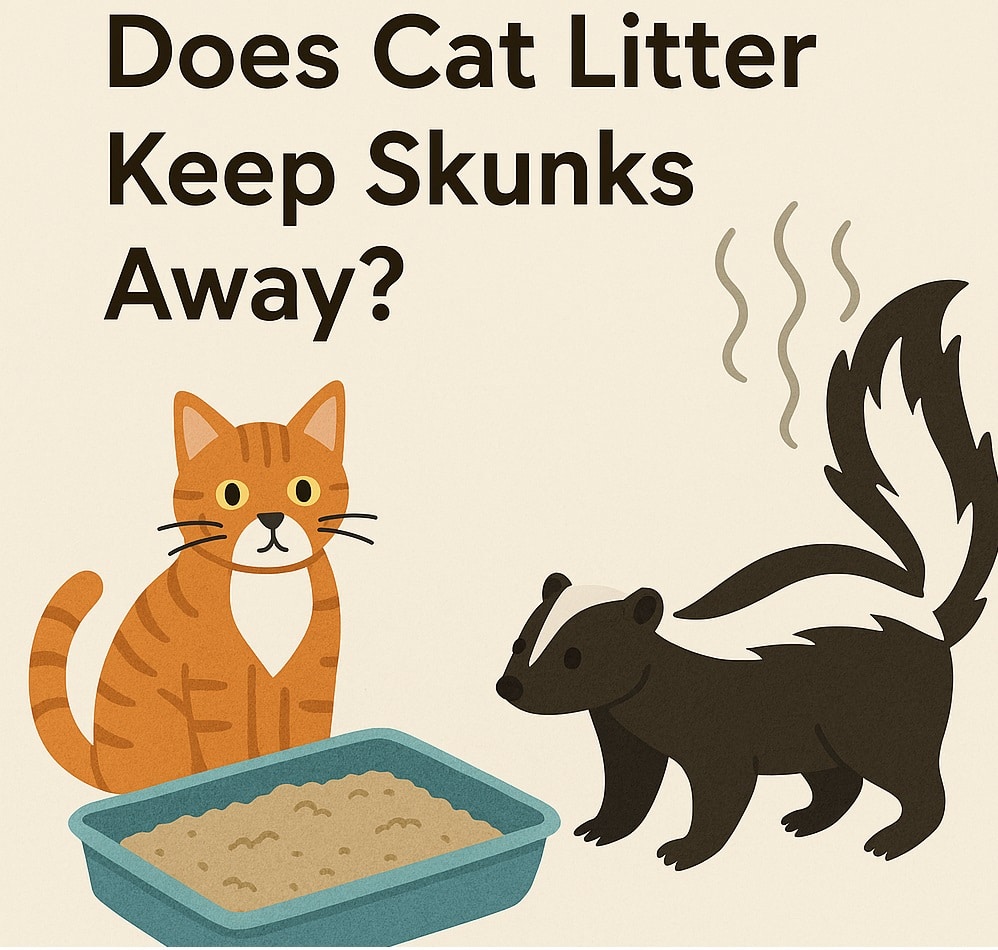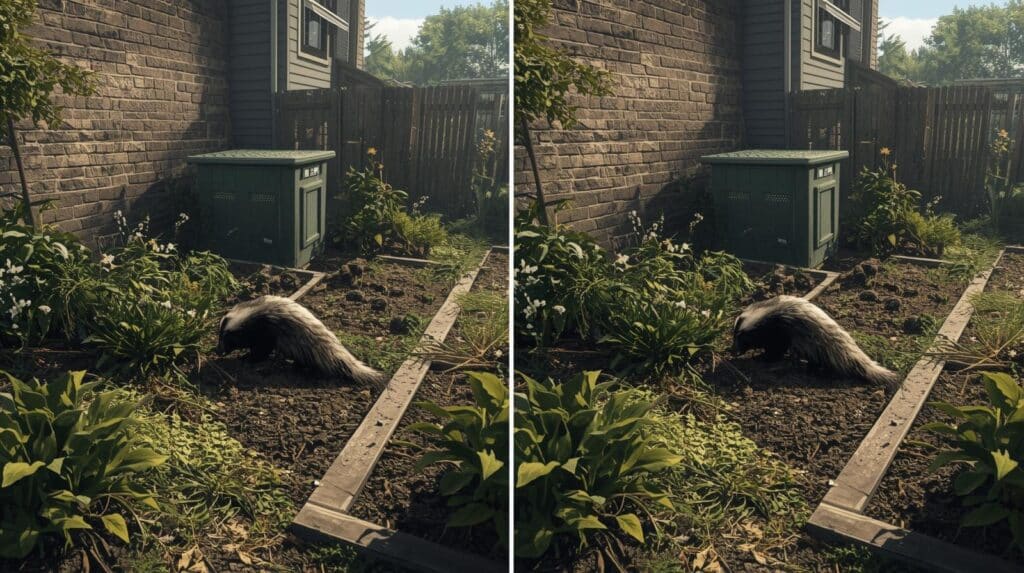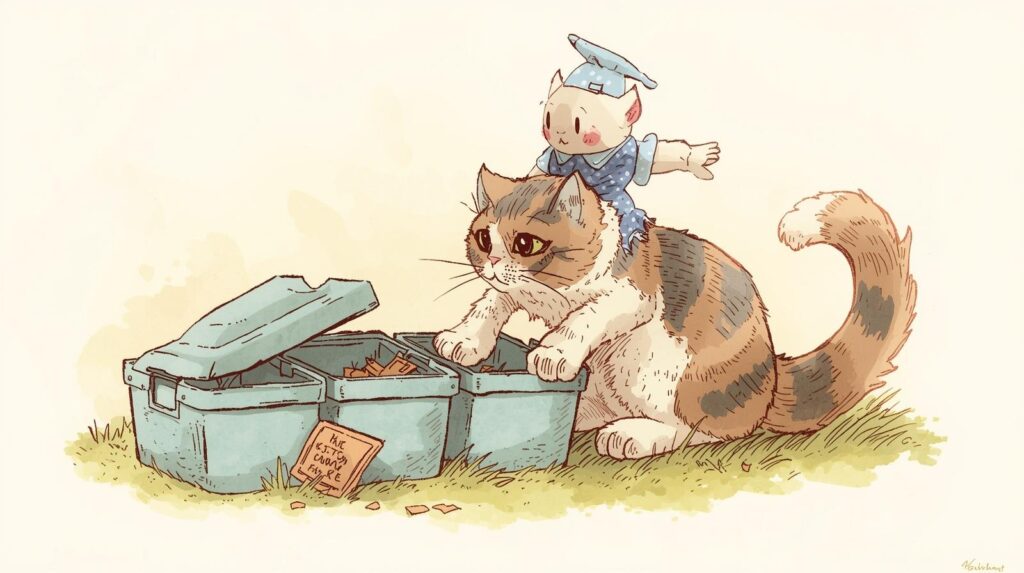
If you’ve ever had a skunk wander into your yard or try to make a home under your porch, you know how quickly the problem can become stressful. Skunks are notorious not only for their pungent spray but also for digging up lawns and nesting in quiet, sheltered spots. Understandably, many homeowners look for natural and affordable ways to keep these animals away—without resorting to harsh chemicals or costly professional services.
One common question that pops up is: Does cat litter really keep skunks away?
The short answer is yes—but only if it’s used correctly and combined with other preventative measures. Used cat litter gives off a strong ammonia smell that mimics the scent of predators, which can trick skunks into thinking the area is unsafe. However, relying on cat litter alone usually won’t solve the problem long-term.
Table of Contents
2. How Cat Litter Works as a Skunk Repellent
The Science: Ammonia in Cat Urine
Used cat litter contains traces of cat urine, which releases ammonia as it breaks down. To many wild animals, ammonia smells like the scent of a predator. In nature, skunks (and other small mammals) rely on scent to detect danger. When they pick up the smell of ammonia, they interpret it as a warning sign that a predator may be nearby. Just like skunks, rodents can also be repelled by cat litter. Learn more in our guide on does cat litter keep rats away.
Skunk Behavior: Why They Avoid Predator-Marked Areas
Skunks are cautious animals. While they have their powerful spray for defense, they generally avoid confrontation. If they sense they’re entering another predator’s territory, they are more likely to move on and search for a safer den site. That’s why placing used cat litter near skunk dens, burrow entrances, or areas you want to protect can be effective.
Skunks are highly cautious animals and rely on scent cues to detect predators. According to the National Wildlife Federation, they are adaptable yet sensitive creatures, which is why strong smells like Predator urine spray, cat litter, natural oil, and ammonia can drive them away.
Fresh Litter vs. Used Litter
It’s important to note that fresh cat litter will not repel skunks. Unused litter is just clay, silica, or plant-based material with no odor that skunks would consider threatening. Only used litter (especially with urine) gives off the strong ammonia scent that mimics predator markings. For best results, homeowners should scoop some used litter and place it strategically near skunk activity areas.
Since ammonia exposure can be risky, especially for pets and kids, it’s smart to understand the ammonia smell in cat litter and safe handling tips.
Top Skunk Repellents (2025)
| Product Name | Type | Key Features | Coverage |
|---|---|---|---|
| Natural Armor Peppermint Spray | Essential oil spray | Pleasant mint scent, safe for pets/kids, biodegradable | ~4,000 sq ft |
| Bonide Repels-All Granules | Multi-ingredient granules | Contains garlic, cloves, dried blood; long-lasting | ~2,000 sq ft |
| PredatorPee Coyote Urine Spray | Odor-based deterrent | Mimics predator scent to scare skunks | Spot treatment |
| RibRave Ultrasonic Repeller | Electronic | Motion-activated, solar-powered, waterproof | Wide outdoor area |
| Epic Skunk Scram Granules | Natural granular repellent | Designed specifically for skunks, weather-resistant | Garden beds, decks |
3. Best Practices for Using Cat Litter Against Skunks
Knowing that cat litter can deter skunks is one thing—using it the right way is another. To actually keep skunks from nesting on your property, placement and consistency are key.

Where to Place It
Used cat litter works best when placed directly in areas where skunks are active, such as:
- At den entrances (under decks, porches, or sheds).
- Along fence lines or garden edges where they dig.
- Near garbage cans or compost piles that may attract them.
Avoid scattering it randomly across the yard—targeted placement is much more effective.
How Much to Use
You don’t need to dump an entire litter box outside. Instead:
- Use a few cupfuls of used litter at a time.
- A thin sprinkle or a small pile near the den entrance is usually enough.
- Overusing it can create a mess and attract other unwanted pests.
How Often to Replace
The scent of ammonia fades over time, especially outdoors. To maintain effectiveness:
- Replace the litter every 3–5 days.
- Refresh after heavy rain or snow, since moisture washes away the odor.
Container Method vs. Sprinkling Directly
There are two main ways to apply cat litter outdoors:
- Container Method: Place small amounts of used litter in open containers (like coffee cans or plastic tubs) with holes. This keeps the litter contained, reduces mess, and still allows the smell to spread.
- Direct Sprinkling: Sprinkle the used litter directly on the soil near the skunk’s den or under structures. This is more direct but can look untidy and may need more frequent replacement.
For most homeowners, the container method is cleaner and easier to manage, while sprinkling may be more effective in areas where skunks are actively digging.
4. Combine with Other Natural Skunk Deterrents
While used cat litter can help drive skunks away, it works best when combined with other natural repellents and preventive measures. Skunks are persistent, so using multiple strategies increases your chances of keeping them out for good.
Motion-Activated Lights & Sprinklers
Skunks are nocturnal and prefer to roam under the cover of darkness. Installing motion-activated lights or sprinklers can scare them away when they approach. The sudden burst of light or water creates an environment that feels unsafe, discouraging them from returning.
Removing Food Sources
One of the main reasons skunks settle near homes is easy access to food. To make your property less appealing:
- Secure garbage cans with tight lids.
- Avoid leaving pet food or water bowls outside overnight.
- Minimize birdseed spillage, as it can attract both skunks and rodents.
- Cover compost piles if possible.
Blocking Den Sites with Fencing or Mesh
Prevention is more effective than eviction. Skunks love sheltered spaces under porches, decks, and sheds. Use chicken wire, hardware cloth, or mesh fencing to block these entry points. For best results, bury the fencing at least 6–12 inches underground to prevent digging.
Predator Urine Alternatives (Coyote, Fox, Dog)
If you don’t want to use cat litter, predator urine products (like coyote or fox urine) are available at garden and pest-control stores. These scents mimic natural predators and can be effective at keeping skunks and other small animals away. However, they need to be reapplied regularly, especially after rain.
5. Safety and Environmental Considerations
While cat litter and other natural repellents can help keep skunks away, it’s important to use them responsibly. Misusing repellents can pose safety risks to pets, children, and the environment.
Risks of Ammonia Exposure to Pets and Children
The strong ammonia smell in used cat litter may deter skunks, but it can also be irritating to people and domestic animals. Direct exposure can cause:
- Eye and nose irritation.
- Breathing discomfort, especially for those with asthma.
- Health risks if ingested by curious pets or children.
For safety, always place used litter in containers or tucked areas where pets and kids cannot access it.
What NOT to Use
Some DIY skunk deterrent methods you may see online are actually unsafe. Avoid using:
- Mothballs – They contain toxic chemicals (naphthalene or paradichlorobenzene) that are harmful to humans, pets, and wildlife.
- Bleach or harsh chemicals – These can pollute soil, harm vegetation, and create health hazards.
- Poison baits – Not only inhumane but also illegal in many regions.
Instead of relying on toxic substances like mothballs or harsh chemicals, homeowners can follow the EPA’s Integrated Pest Management principles for safer, eco-friendly ways to deter pests
Eco-Friendly Alternatives for Pet Owners
If you want to avoid ammonia-based repellents altogether, consider these eco-friendly options:
- Motion lights and sprinklers – Harmless deterrents that don’t involve chemicals.
- Citrus peels or vinegar sprays – Skunks dislike strong acidic scents.
- Castor oil mixtures – Safe for the yard but unpleasant for digging animals.
- Secure fencing – A long-term, safe, and effective method.
Using these safer alternatives not only protects your family and pets but also keeps your yard environmentally friendly.
6. Seasonal & Regional Factors
When it comes to skunk control, timing and location matter. Skunks exhibit different behaviors depending on the season, and laws regarding removal or relocation vary from place to place. Understanding these factors will help you plan the most effective and responsible strategy.

Spring: Skunk Denning Season
Spring is the most critical time to deter skunks. This is when females look for safe, sheltered spaces to give birth and raise their young. If they find a cozy spot under your porch or shed, it can be very difficult to evict them without disturbing the babies. Applying deterrents like cat litter in early spring—before they settle in—can prevent problems before they start.
Winter: Less Active but Still Present
In colder climates, skunks do not fully hibernate, but they do become less active. They often gather in groups and seek warm, sheltered dens. Even in winter, they may venture out during milder days to search for food. This means deterrents like cat litter can still be useful, especially around potential denning sites.
Regional Laws on Trapping or Relocating Skunks
It’s important to know that trapping and relocating skunks is not always legal. Wildlife regulations differ by region:
- Some areas require permits to trap skunks.
- Relocation may be prohibited due to the risk of spreading diseases like rabies.
- Humane removal methods, such as one-way doors, are often recommended instead.
Before attempting to trap or relocate a skunk, always check with your local wildlife agency or pest control service to ensure you’re following the law.
7. Conclusion
Used cat litter can be a surprisingly effective tool in deterring skunks, thanks to the strong ammonia odor that mimics predator scent. However, it isn’t a one-size-fits-all solution. On its own, cat litter may only offer short-term results, especially outdoors, where the smell fades quickly.
For long-lasting success, it’s best to combine cat litter with other prevention methods—like sealing off den sites, removing food sources, and using motion-activated deterrents. This layered approach makes your property far less attractive to skunks.
Above all, choose safe and humane strategies first. Skunks play an important role in ecosystems by controlling insects and small pests, so deterring them without harm is always the better option. If the problem persists, consult local wildlife professionals before considering trapping or relocation.
8. FAQs
Does fresh cat litter work to keep away skunks?
No. Fresh litter—whether clay, silica, or plant-based—does not affect skunks. The deterrent comes from the ammonia in used cat litter, which mimics predator scent. Without urine, there’s nothing to repel them.
Does tomato juice remove skunk smell?
This is one of the biggest myths. While tomato juice might mask the odor temporarily, it does not neutralize the skunk spray. A better solution is the proven mix of hydrogen peroxide, baking soda, and dish soap, which breaks down the sulfur compounds responsible for the smell.
How long does cat litter smell last outdoors?
The ammonia smell fades quickly in outdoor conditions. On average, the scent lasts 2–5 days, depending on the weather. Rain, snow, or even heavy dew will wash it away faster, so regular replacement is necessary.
Can cat litter keep away other animals (raccoons, possums)?
Yes, to some extent. Many small mammals, including raccoons, opossums, and rabbits, are cautious around predator scents. However, effectiveness varies—some animals may ignore it, especially if food sources are nearby.
Is it safe to put used cat litter in my garden?
Used cat litter should not be mixed directly into your garden soil, especially in vegetable beds. It may contain harmful bacteria (like toxoplasmosis) and ammonia that can damage plants. If you want to use it as a repellent, place small amounts in containers or spread it on pathways outside of growing areas.
Do skunks hate the smell of ammonia?
Yes. Ammonia (from cat urine or household cleaners) smells like predator scent to skunks, which can make them avoid the area.
Can I use kitty litter indoors to repel skunks in basements or crawl spaces?
It’s not recommended indoors—odor buildup can harm people and pets. Instead, place it outside near entry points.
Will cat litter attract other animals instead of repelling them?
It may attract curious pets (cats, dogs) but typically discourages wildlife like skunks, raccoons, and rabbits.
What time of year are skunks most likely to invade yards?
Spring (denning season) and fall (when they’re foraging heavily before winter).
What’s the best natural alternative to cat litter for skunks?
Predator urine (coyote/fox), citrus peels, vinegar sprays, and castor oil solutions are common alternatives.
How can I tell if a skunk has made a den on my property?
Look for dug-up soil, small burrow entrances (3–4 inches wide), and musky odors under decks, porches, or sheds.


